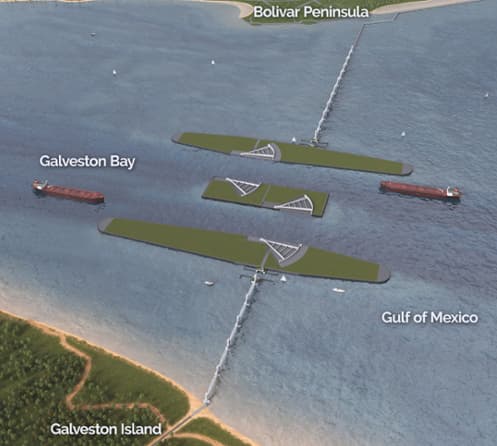Defense Bill Passes, Includes Ike Dike
January 10, 2023
Tweet
By Taylor Bounds, Content Specialist
On Friday, December 23, 2022, fourteen years after Hurricane Ike ripped through the Texas coast, President Biden signed the National Defense Authorization Act (NDAA) for Fiscal Year 2023 into law. The annual defense bill, totaling $847 billion, includes the approval of the $34 billion proposal for the Texas coastal barrier project, with $16 billion allocated to the colossal concrete gate system colloquially known as the Ike Dike. The Texas coastal barrier is the largest of the coastal protection projects in the NDAA, which includes deepening shipping channels and raising homes and businesses in other parts of the country.
After Hurricane Ike devastated Galveston and the surrounding areas, causing several dozen deaths and over $30 billion in damage, Dr. William Merrell, professor in the Department of Marine and Coastal Environmental Science at Texas A&M University at Galveston, developed plans for the coastal barrier project. Modeled after successful projects in the Netherlands, the Ike Dike would help prevent costlier and deadlier damage from future storms.
The Gate System
Cutting across the two miles of water between Galveston and Bolivar, the Ike Dike gate system would open and close (see the flyover view from the Houston Chronicle here). Under direction of the Army Corps of Engineers, the gate will take about two decades to build, but will eventually protect both the Galveston and Houston ship channels from potentially hundreds of billions of dollars of damage and catastrophic environmental consequences.
As climate change drives rising oceans, the coastal barrier takes a multifaceted approach. The Ike Dike, a system of levees and gates, is the largest of the three-part project. When complete, Galveston Island to the Houston ship channel will be protected against storm surges up to 22 feet. The gates will be large enough for sizable ships to pass through and will close with the risk of a storm surge.
The Sand Dunes
Sand dunes, requiring millions of cubic yards of sand, will protect the island from erosion and stronger hurricanes. The dunes will be between 12 and 14 feet tall, running along the entirety of the west end of Galveston Island and along 25 miles of the beaches on Bolivar Peninsula. The sand dune restoration will change the landscape, with two rows of dunes planned, but provide significant protection against a potential storm surge by acting as a barrier.
The Floodwall
The third component is a floodwall that will protect much of the central infrastructure of the island against a storm surge. Surrounding the community from Harborside through Offats Bayou to Seawall, the floodwall will be able to close in the event of a storm surge, and water will be pumped from inside the barrier into the bay.
Altogether, the coastal barrier is the largest infrastructure project in the nation. With estimates that by 2050, the sea level along the coast of the contiguous United States could rise by up to twelve inches, coastal communities across the nation are forced to prepare for the worst, and this comprehensive approach sets a standard for storm preparedness that we have yet to see in the US.
With a 20 year construction timeline, Dr. Merrell said “I just hope the end product comes and it protects my children and grandchildren and all the other citizens of this area.”
###
Media contact:bounds@tamug.edu
More:
Read more about Health & Environment
Read more about Science & Technology
Read more about Foundational Sciences
Read more about Marine Sciences